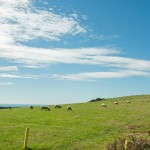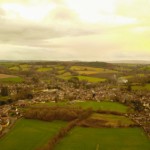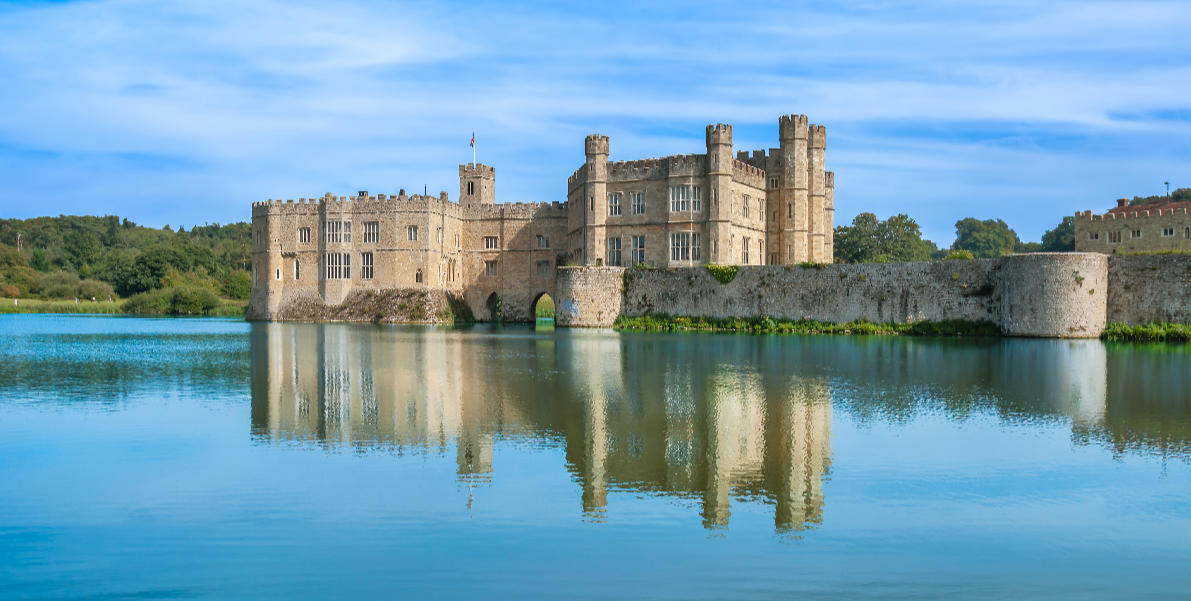
Maidstone lies on the banks of the River Medway in South East England. It’s the largest settlement in Kent, where it serves as the county town. It lies 32 miles (52 km) south-east of the centre of London and 8 miles (13 km) south of Gillingham. Historically, the town has been very much at the centre of Kent’s agricultural, brewing and paper industries.
In the Beginning
Archaeological evidence found in the area strongly suggests there was habitation by the late Stone Age, if not earlier. The Romans were certainly also active in the area as the famed Watling Street, between Rochester and Hastings, passed through present-day Maidstone. They, at the very least, established temporary camps in the area to quarry the local sandstone to construct the road.
Medieval Maidstone
Maidstone itself started out as a small Saxon settlement in the early 7th century. Sometime during the 10th century, the land around was bestowed to the Archbishop of Canterbury. By the time of the drafting of the Norman Domesday Book (1086), ‘Meddestane’ as it was then named, was a large village, for its time, with a population of around 250. In 1146, Cistercian Boxley Abbey, 3 miles away, was founded by William of Ypres. It’s presence meant that Maidstone became a popular stopover for pilgrims on the way to Canterbury, especially following the murder of Thomas Becket in 1170.
During the 13th century, Maidstone grew from a village into a small town. The River Medway provided it with good transportation links, meaning locally grown fruit and vegetables could be readily moved to markets in London. In 1267, the town was granted a market charter, allowing it to hold weekly markets and an annual fair. Its favourable location became a key factor in its growth.
By the early 14th century, Maidstone’s population had grown to more than 2000, a good-sized market town of the time. However, the arrival of the plague in the mid-14th century devastated the town’s population growth and development. The end of the 14th century saw the All Saint’s Church, commissioned by Archbishop Courtenay, being completed. The soul-saving ‘College of Secular Canons’ was also established in the town at the same time.
Turbulent Times
In 1450, Jack Cade dubbed the ‘Captain of Kent’ led a popular revolt against the government and the unpopular Henry VI on the issues of taxation and corruption. He raised a civilian 5,000 strong army, consisting of a strong Maidstone contingent, to march on London. The rebellion ended on 12 July when Cade was killed by Alexander Iden, near Lewes in Sussex, whilst attempting to flee a skirmish.
In 1530, Thomas Hitton, considered to be the first English Protestant martyr of the Reformation, was captured at Gravesend attempting to feel the country. He was condemned of heresy by Archbishop William Warham and Bishop John Fisher and was burned at the stake at Maidstone on 23 February 1530. Henry VIII’s Lord Chancellor, Thomas More, described Hitton as “the devil’s stinking martyr”.
In 1537, the jurisdiction of Maidstone, which had been overseen by the Archbishops of Canterbury for some 600 years, transferred to the Crown. In 1549, a new town charter was duly granted by Edward VI. It gave Maidstone more rights in running its own affairs, including education, and thus, a grammar school went on to be quickly established. However, when Maidstone showed support for Thomas Wyatt’s rebellion against Queen Mary in 1554, the charter was revoked. Wyatt who based himself at Rochester had been riled by Mary’s decision to marry the ‘Catholic’ Prince Phillip of Spain. However, in 1558, when Queen Elizabeth I came to power, Maidstone’s charter was quickly reinstated and the town duly declared a borough.
The Battle Of Maidstone
By the end of the 16th century, Maidstone’s woollen industry was thriving. However, the town suffered a setback when a significant bout of the plague struck between 1593 and 1595. However, Maidstone quickly recovered from the misfortune and the town’s population continued to grow.
From the beginning of the English Civil War in 1642, Maidstone like much of Kent had largely sided with Parliament. However, when the government tried to quell the Christmas celebrations of 1647, sentiments in Kent quickly turned against Cromwell’s rule. This led to one of the most significant occurrences during the Civil War when the ‘Battle of Maidstone’ took place on 1 June 1648.
Kentish Royalists had taken advantage of local anti-government feelings and managed to secure a number of Kent’s key towns, including Maidstone. Up to 2,000 royalists were defending the town led by Sir James Pearse when Parliament troops led by General Fairfax attacked. The all-day hand-to-hand fighting resulted in a victory for the New Model Army. The skirmish saw the death of 300 Royalists and the capture of more than 1,300 others. It was reported that only between 30 and 80 of the Parliamentarian army were killed.
The Georgian & Victorian Era
By the turn of the 18th century, Maidstone’s population was around 4,000. The dawning of the Georgian period saw real prosperity and a rise living standards for many of Maidstone’s residents. By this time there were numerous industries, shops, inns and professionals in the town. There were at least six breweries operating in the area by this time. Maidstone had also become a prosperous market town, holding a weekly market, four annual fairs, regular Sunday fairs, and a monthly cattle market. By the 1730s, paper making had been established in the town. The first paper mill in Maidstone was Hurst Mill (or Boxley Mill) on the River Len, originally a fulling mill.
In 1763, the new town hall building was completed, which also served as the town goal until the 182os. In 1797, an army barracks was built at Maidstone’s in response to the growing threat of invasion by the French. The barracks became the home to the West Kent Regiment. In 1799, George III and PM William Pitt visited the town’s, Mote Park. They inspected the 3,000 assembled troops of the local militia, the Kent Volunteers.
By 1801, Maidstone’s population had grown to about 8,000. In 1813, Maidstone Barracks became a cavalry depot, and would later become the Army Riding School. By the mid-19th century, it also became an induction centre and staging post for soldiers being sent to the colonies. Some of the 19th-century developments in the town included the introduction of gaslighting in 1822, the opening of the first railway station in 1844, the opening of a museum in 1856, and the opening of Brenchley Gardens public park in 1879.
The War Years
By 1901, Maidstone’s population had reached around 33,000. Some pre-war changes to Maidstone saw electric trams running in streets by 1904, and the first cinema opening in 1910.
Even before the official outbreak of WW1 in August 1914, more than 2,000 Territorials reported to Maidstone. As the HQ of the Home Counties Division of the Territorial Force, the base was tasked with designating its members to their war stations. In 1916, a royal naval air station (RNAS) opened at Detling, 3 miles north-east of Maidstone. RNAS Detling remained in operation until 1919.
In 1939, Detling re-opened as a Royal Air Force base and was assigned to Fighter Command’s No 11 Group. On 27th September 1940, Maidstone suffered its worst day of bombing when more than 50 bombs fell on the town. One of Maidstone’s most tragic wartime incidents occurred on 10th October 1940, during the Battle of Britain. A Hurricane of No.253 squadron, unfortunately, crashed into houses in Albion Place. The pilot, together with 2 adults and 6 children, all from the same family, was sadly killed.
Maidstone suffered further Luftwaffe bombings and both attacks from V-1 flying bombs and V-2 rockets. In total, 53 civilians were killed in the town during the conflict.
The Modern Era
After the war, Maidstone like most towns and cities in Britain introduced both a council and private house building programme. And, like most of the country, Maidstone enjoyed almost full employment. However, by the early 1970s, the town’s manufacturing sector went into decline.
By that time Maidstone’s breweries had closed down apart from Goachers. The small niche brewery remains open to this day (2021) supplying its 20 or so pubs throughout Kent with a selection of ‘real’ ales. Part of the former Fremlin’s Earl Street brewery site was adopted for the Fremlin Walk shopping centre which opened in 2005. Maidstone’s paper industry went on to suffer much the same fate as its brewers. Through a series of closures and mergers of papermaking companies in the UK, operations in Maidstone had all but ceased by the 2000s.
Today, unlike the past, manufacturing only makes up a small portion of Maidstone’s economy. The major employment sectors in Maidstone are retail & wholesale, public administration and health & social work activities. In 2011, the time of the last National Census, the town’s population was recorded as 113,137.
There are a whole host of annual events and festivals in the Maidstone calendar. The Maidstone Fringe Festival features local bands as well as well-known artists. It takes place across a number of venues over the course of the May Bank Holiday weekend. ‘The Ramblin’ Man Fair’ is a classic rock, country & blues concert, which is staged in Mote Park during the summer. Leeds Castle stages a Classical Concert and the Festival of Flowers, during the summer months, as well as a Christmas market.
The Kent County Show, showcasing farming and rural life, is a 3-day event that takes place every July at Detling. Additionally, Kent Life at Sandling hosts the annual ‘Hops ‘n’ Harvest Festival’ and the ‘Apple and Cider Fayre’, both of which feature music and other entertainment.
Getting to Maidstone
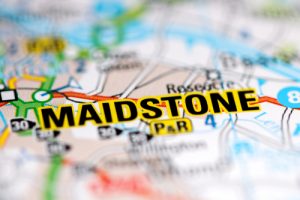
Image Credit: SevenMaps/Shutterstock.com
By Car
Getting to Maidstone from most of the country by car is straightforward. Just head towards London and then take the M25 circular road. Then turn off for the A2 just South of the Thames, or alternatively the M20, which is about 3 miles further on. It’s about 16 miles to Maidstone from either turn-off.
By Coach
National Express operates a regular coach service from London Victoria Coach Station to Maidstone. The 36-mile journey usually takes between 45 and 90 minutes depending on your time of travel.
By Train
Getting to get to Maidstone from almost all of the country will mean heading to London first. There are direct trains from London Victoria to Maidstone which take about an hour. You can also get to Maidstone from St Pancras International and Charing Cross but you may have to change trains.
By Air
The nearest airport to Maidstone is Southend Airport, about 34 miles away, but it has a very limited flight schedule. London City Airport is about 41 miles and has flights to/from domestic and European destinations only. The nearest major international airport is London Gatwick which is around 51 miles away.
Did you know?
- In 1976, NASA named one of the geological features on the planet Mars the ‘Maidstone’ Crater.
- The unique ‘Teapot Island’, at Yarling, started out as a fishermen’s shack, serving tea, in the 1950s.
- In 1946, Maidstone’s newly redesigned ‘Coat of Arms’ was the first in the world to feature a dinosaur. An acknowledgement of the unique Iguanodon skeleton find in the town in 1834.
- Maidstone’s name at the time of the Domesday Book (1086) ‘Meddestane’, translates from Old English as the ‘Maiden’s stone’.
- On 28 April 1868, the last woman to be publicly hanged in Britain, took place at Maidstone Prison. Frances Kidder, aged 25, was found guilty of murdering her step-daughter.
- Maidstone is twinned with Beauvais in Picardy, France.
Notable People
A few of the notable people born in Maidstone include:
- Sir Garrard Tyrwhitt-Drake (1881 – 1964) – known to friends as ‘Hugh’, was an entrepreneur, philanthropist, zoo owner and author. Between 1915 and 1950 he was elected as Mayor of Maidstone on 12 occasions, and in 1956–57, served as the High Sheriff of Kent. In 1936, he was knighted for his political and public services to Kent. He also owned the UK’s largest private zoo, which was housed at his Cobtree Manor estate. Sir Garrard was born in Maidstone on 22nd May 1881.
- James Smith VC (1871 – 1946) – was a recipient of the Victoria Cross, the highest and most prestigious medal awarded for bravery to a member of the British armed forces. The 26 years old, corporal of the East Kent Regiment (The Buffs) earned the medal during the First Mohmand Campaign, while serving in India. Though wounded, he maintained fire at the enemy, exposing himself to mortal danger, that allowed two wounded officers to be rescued. Born in Maidstone in 1871, the exact date of Smith’s birth is unknown.
- Norman Antony Hart (1925 2009) – better known to all as ‘Tony Hart’ was a renowned artist and long-time children’s television presenter. His television career began in 1952 and lasted until 2000. He specialised in teaching art to children through his TV shows, which included; Playbox (1954–59), Vision On (1964–76), Take Hart (1977–83), Hartbeat (1984–93), Artbox Bunch (1995–96) and Smart Hart (1999–2000). Tony was born in Maidstone on 15 October 1925 and graduated from the town’s Kent Institute of Art & Design in 1950.
Sport In Maidstone
Maidstone United FC
Maidstone United FC currently (2021) compete in the National League South, the sixth tier of English football. Nicknamed ‘The Stones’, they play their home games at the Gallagher Stadium, which has a capacity of 4,200.
Maidstone RFC
Maidstone RFC currently (2021) play its rugby in London Division 3 (South East). Nicknamed ‘Stones’, the club plays its home games at Mode Park.
The Mote Cricket Club
‘The Mote’ Cricket Club (aka Mote Park CC) current play in the Kent Cricket League and play home games at Mote Park.
Maidstone Hockey Club
Hockey is a big deal in Maidstone! Maidstone HC runs some 18 sides, consisting of Men’s, Ladies, Boys and Girls teams. The club plays its hockey in the Kent Leagues and home games take place at South Park.
Things to see in Maidstone
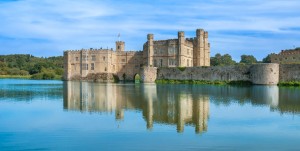
Image: Petrin Evgenii/Shutterstock.com
There’s a surprising number of things to see in the Maidstone area, a few recommendations are:
- Leeds Castle – has been described as “the loveliest castle in the world”. As one of the most visited historic places in Britain, it would seem many agree with the sentiment. The former Norman stronghold, and the royal palace, still has an impressive moat and there’s also 500 acres of parkland, a maze and an underground grotto to explore. If that’s not enough, there’s falconry displays, boat trips and train rides at the site.
- Teapot Island – is located at the confluence of the Medway and Teise rivers, at Yarling, 7 miles southwest of Maidstone. The unique “island’ museum houses what is reputed to be the world’s largest collection of teapots that have been sourced from across the globe. There’s a bistro-style café that obviously serves a good cup of tea. And, should you want a memento of your visit, there are at least 2,000 uniquely designed different teapots for sale.
- Maidstone Museum & Art Gallery – has a collection of more than 600,000 objects and artefacts. It also hosts temporary exhibitions. Exhibit themes include; ancient Egyptian, archaeology, costume, fine and decorative art, geology, and Japanese decorative arts and prints. The museum is located in the centre of town and opens seven days a week, with free admission.
- Kent Life – is an outdoor rural life museum at Sandling, near Adlington Lock, about 4 miles north of Maidstone. The museum consists of a collection of historic buildings that include a chapel, a village hall and several houses. There’s also an agricultural display, including a farmyard with live farm animals.
- The Tyrwhitt-Drake Museum of Carriages – is housed in the Grade I-listed Tithe Barn in the centre of town. The museum was established by Sir Garrard Tyrwhitt-Drake, a former mayor of Maidstone, who amassed a collection of more than 60 horse-drawn vehicles and other transport-related artefacts.
- Stoneacre – is a near-original medieval 15th-century yeoman’s house and garden in Otham, about 4 miles from Maidstone. The house features a distinctive collection of 17th-century furniture, soft furnishing, glass and decorative metalwork. There’s also a refined library tearoom on site.
Things to do in Maidstone
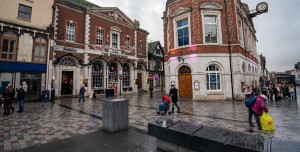
Image: Linas Gircius/Shutterstock.com
Things to do in Maidstone include:
- Shopping – Located at the site of a former brewery, Fremlin Walk is Maidstone’s main shopping centre. There are more than 50 stores in the complex, ranging from large national chain stores to bespoke independent traders. Jewellers, in particular, have a strong presence in the centre.
- Cobtree Manor Park – was created in the 1970s on the site of the former Maidstone Zoo. More than 600 different species of trees and shrubs were planted in the early 80s but only the 220 or so tree species survive. The old elephant house is now a volunteer ‘man’ shed. There’s also has a popular café, picnic area, zip wire and playground. The park is open every day except Christmas day. Parking is around £2 for the day.
- Go Ape Adventure Park – is a treetop experience located on the grounds of Leeds Castle. The course rises some 40 ft (12 m) above the forest floor and consists of a 250m long zip wire, Tarzan swings, high ropes, etc., set amongst the treetops.
- Mote Park – is a free-to-enter 180-hectare open-space mix of grassland, woodland and small lakes, dating back to the 13th century. If you want more, then there’s also a pitch and putt golf course, an opportunity to do water sports and a good chance of observing a good mix of wildlife.
- Teston Bridge Country Park -is a popular Maidstone attraction that offers riverside walks in 32 acres of prestige countryside. The park also features the 14th-century Teston Bridge and a children’s playground. Bridge Meadow is a favourite with picnickers during the summer months.
Where to stay?
Accommodation in Maidstone itself is fairly limited, although the surrounding towns and villages offer plenty of alternatives. If you’re on a limited budget, say £40 – £60 range, then try the likes of Rochester or Chatham 5 – 8 miles away. A broad price guide for an overnight stay in Maidstone for 2 adults sharing is:
Inn/Guesthouse/Lodge/Small hotel: £60 – £90
Luxury Hotel: £90 – £200
Thinking of moving here?
Are you thinking of moving to Maidstone? Over the last 12 months, properties in Maidstone have fetched an overall average price of £314,700 (Jan 2021). In the last year, the town’s best-selling properties have been semi-detached houses, which have sold for an average price of £327,200. Flats sold for an average of £172,400, terraced properties for £258,400, with detached properties fetching £473,000. The average property in Maidstone has in the last 12 months sold for around 1% more than in the previous year.
So there you have it our Five Minute tour of Maidstone the place with the castle which its self makes it worth a visit. Before you go why not try some of our other quizzes or have a look at some of our other location guides. better still why not join our growing community it’s free and could be very rewarding going forward.


